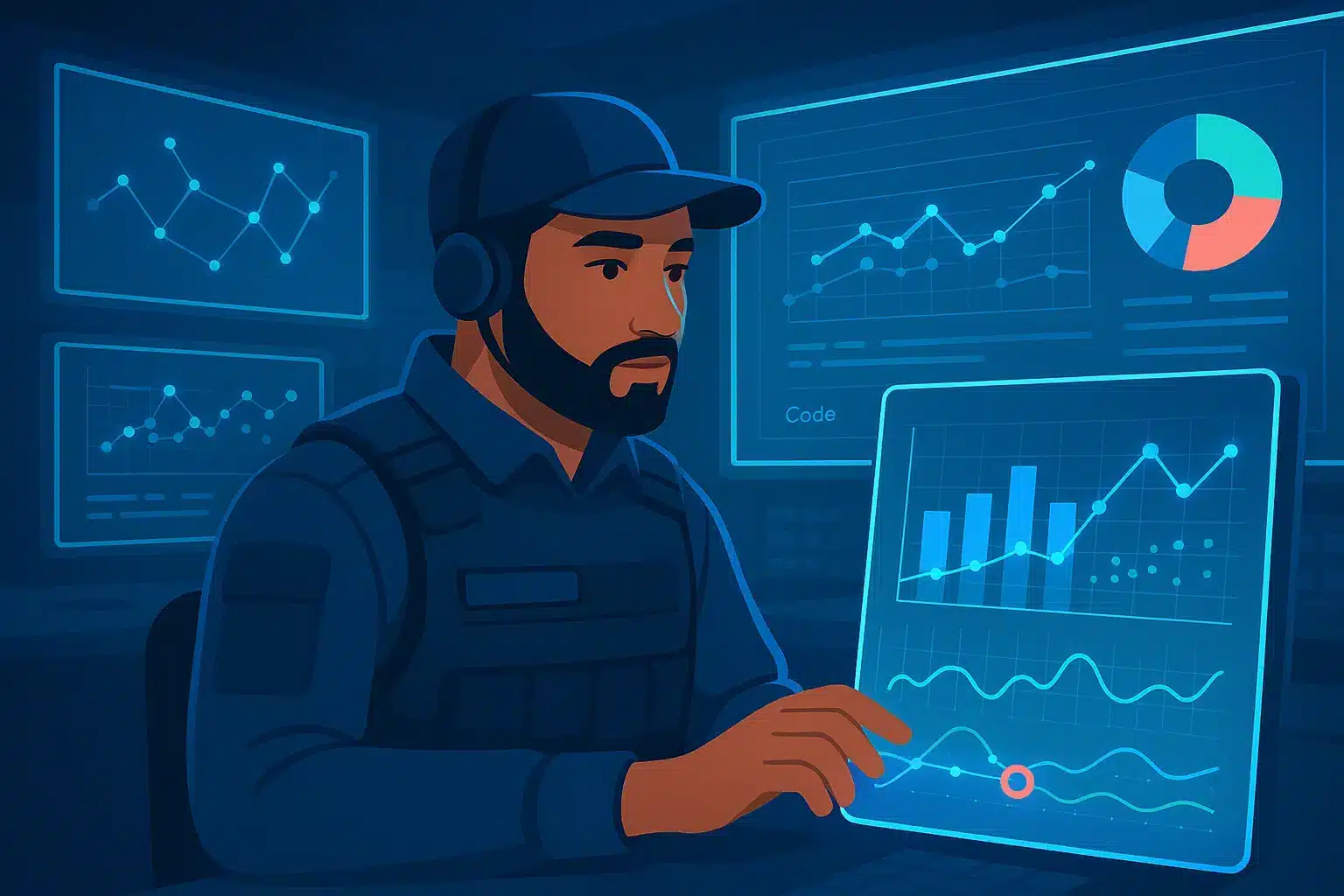Palantir is a technology company specializing in the advanced analysis of big data. Originating within the sphere of American intelligence, it is now employed by militaries and industries alike. Discover its flagship tools, its role in the new era of generative AI, as well as the controversies it incites!
Data is a buzzword that everyone discusses. However, very few truly comprehend how to handle it on a large scale, combining rigor, speed, and impact. Today, companies aim to forecast inventory shortages, governments seek to predict conflicts, and hospitals strive to save lives before symptoms manifest. Behind the scenes, a discreet player orchestrates all of this: Palantir.
Frequently mentioned with a mix of fascination and fear, this company, founded in the early 2000s at the confluence of intelligence and Silicon Valley, has established its vision of “operational” data analysis. Palantir is neither a database nor a simple analytics tool; it claims to be a strategic brain that can convert informational chaos into clear decisions.
But what exactly does this company do? Why are its tools as prevalent in the U.S. military as they are at Airbus or Sanofi? We’ll explain!
A startup created by the CIA
Palantir isn’t just another startup. It was born within the CIA through its technology investment arm, In-Q-Tel. Its initial mission was straightforward: counterterrorism by making data comprehensible for analysts. Its name, inspired by the seeing stones from The Lord of the Rings, sets the theme: it’s about “seeing through data”.
Unlike the GAFAM firms that monetize your clicks, Palantir sells ultra-powerful analytic platforms to governments and large corporations. It leverages three flagship products. First, Gotham is dedicated to intelligence agencies and armed forces. This tool is used to sift through billions of data points (radar, terrain, cyber, human intelligence…) identifying threats, planning missions, or mapping out networks.
Foundry is aimed at the industrial and civic sectors, enabling the connection, cleaning, visualization, and modeling of an organization’s data. It’s catered to both data engineers and business users. Less known to the public, Apollo serves as the software deployment engine, keeping Palantir’s platforms updated in real-time, even in highly sensitive environments.
Palantir’s positioning is distinct: it doesn’t sell lines of code or dashboards. It provides an intelligence overlay—a framework in which complex or dispersed data become actionable, fundamentally altering outcomes.

A discreet but essential player
Palantir is not spotlighted at the top tech podiums. There are no flashy keynotes, mainstream advertising, or a smartphone app. Yet, the company’s footprint is massive. Defense, intelligence, energy, healthcare, industry… today, it’s challenging to find a strategic sector devoid of Palantir’s involvement.
In the governmental arena, Palantir provides services to the U.S. military, intelligence agencies, the Department of Homeland Security, and even the New York Police. In Europe, it worked with the UK’s NHS during the Covid crisis to coordinate hospitals and manage vaccine supply. In France, it collaborates with Airbus, Sanofi, TotalEnergies, and various public entities, though few publicly announce the partnership.
Palantir’s model? An integrated, ultra-proactive approach, embedding its engineers within client teams to customize tools for on-the-ground realities, resulting in deep-rooted implementations—both a strength and a controversy. While Palantir shines with its efficacy, it provokes discomfort.
Its connections with the CIA, its role in U.S. immigrant surveillance, and its openly close ties to conservative political figures (such as Peter Thiel, its co-founder) foster an ambiguous image, blending brilliant innovation with opaque power…
Foundry, the favorite platform of data workers
Gradually, Foundry is attracting major corporations. Initially perceived as a simple data management and analysis platform, it’s actually a complete environment enabling data to thrive, end-to-end, without drowning in technical complexity.
It begins with a pipeline: ingestion, normalization, ensuring data quality, and transformation. This unfolds within an intuitive visual interface harmonizing business and engineering needs. Where traditional data projects require multiple tools, Foundry consolidates everything: exploration, modeling, governance, scenarios, monitoring, and automation.
Its standout feature is the use of “Ontologies”: a method of modeling business reality, not as rows of data but as living objects (trucks, warehouses, patients, machines…). This semantic layer renders operational use cases visible and accessible for all, even without a technical background.
At Airbus, Foundry was utilized to optimize the supply chain for aircraft parts. At Merck, it aided in anticipating medicine shortages during the pandemic. And at Ferrari, it’s crucial for managing F1 car performance.

Gotham, the tool that equips the military
While Foundry caters to industrial needs, Gotham is designed for battlefield scenarios. Initially crafted for the CIA and FBI, this software allows the cross-referencing, visualization, and analysis of vast amounts of operational data in real-time.
In Gotham’s web, every event, individual, and GPS coordinate functions as a node. Its goal is to provide analysts, military personnel, or police with a complete and synthesized visualization of complex situations, often under extreme conditions. In Iraq or Afghanistan, Gotham helped identify terrorist networks, predict their activities, and execute targeted raids. In criminal investigations, it’s used to trace contact chains, analyze recordings, and uncover patterns invisible to the naked eye. However, this power prompts a crucial question: to what extent can we automate human intuition? Palantir assures that humans remain “in the loop”, yet in reality, algorithms increasingly drive tactical decisions.
This raises a contentious debate: are we willing to delegate life-or-death decisions to an interface? Where does legitimate surveillance end, and authoritarian overreach begin? This duality is central to Palantir’s uniqueness: a protection tool with formidable capabilities, necessitating constant vigilance regarding its applications.
Palantir in business: a winning bet?
Beyond the military sphere, Palantir increasingly attracts large industrial and logistics corporations, weary of stalled data initiatives. The company offers speed and coherence, making data instantly usable for decision-makers.
With its modular architecture, Foundry facilitates the connection of ERPs, IoT sensors, Excel files, and external APIs within a unified environment. Teams can then create dashboards, automate alerts, and conduct impact simulations, such as “What occurs if a supplier fails?.”
What truly distinguishes Palantir is its operational dimension. Other tools stop at data visualization, whereas Palantir extends to recommendation, execution, and impact monitoring. In essence: a warehouse can autonomously adjust orders, and a factory can reconfigure its production in real-time.
Is it effective? Reviews are overwhelmingly positive. Stellantis reduced logistics costs, BP optimized offshore operations, and American hospitals decreased ER wait times. It’s the realization of activated, industrialized, and embodied data. Yet it also raises another question: should one entrust an increasing proportion of their processes to a company as proprietary as Palantir?

Controversies and criticisms: the flip side
Discussing Palantir invariably involves examining the grey areas of its operations. Behind its reputed tool efficacy is a series of controversies that shadow its reputation.
The primary concern: historical connections with American intelligence. While the company prides itself on defending Western principles, it has been implicated in mass surveillance programs, tracking migrants (with agencies like ICE), and military assistance in sensitive regions. Some in the tech community regard it as the anti-Google—not technologically, but ideologically.
Another frequent critique: the lack of transparency. Palantir delivers powerful platforms yet reveals little of its operational models, pipelines, or scoring rules. For some AI ethics researchers, this results in a particularly perilous “black box” effect, where crucial decisions are based on algorithms with unknown biases.
Others point to a risk of technological dependency. Once organizations configure their data and workflows around Foundry or Gotham, reverting is difficult. The interfaces are proprietary, and technical support predominantly originates from Palantir’s teams. But perhaps this is strategic: creating tools so indispensable and deeply entrenched in processes that they become irreplaceable… even to their critics.
Palantir and generative artificial intelligence
Since 2023, Palantir has accelerated its commitment to generative artificial intelligence by embedding LLMs (Large Language Models) within its Gotham and Foundry platforms. However, this isn’t about mere chatbots. The ambition is clear: to foster AI-human collaboration.
The concept is straightforward: a user can phrase a request in natural language, such as, “Simulate for me the impact of a blockade on the supply chain in Southeast Asia.” The AI then produces scenarios, visualizations, and even recommended actions based on the company’s internal data and external sources (news, weather, logistics flows…).
Palantir now discusses AI Agents: entities capable of acting within the system, conversing with other agents, orchestrating complex plans under human oversight. In Gotham, these agents might, for example, anticipate enemy actions using sensor data and recommend maneuvers. In Foundry, they can automatically reallocate stocks or predict machine failures. A true revolution!
But once again, how do we ensure AI does not independently make irreversible decisions? Who controls the agent, and by what standards?

What future for Palantir?
Despite its increased visibility, Palantir remains enigmatic. Amidst rising U.S. government contracts, the company is focusing on the European private sector as a growth strategy. Fields like health, energy, transport, and climate represent major 21st-century challenges and serve as arenas for its Foundry platform.
Palantir’s narrative is evolving: it once described a “war on terrorism” but now positions itself as a partner in technological sovereignty, a Western shield against Chinese tech giants and challenges from the GAFAM. Its CEO, Alex Karp, boldly claims a political role: that of a company that “takes a stand” in an unpredictable world.
However, competition is brewing. More transparent, open-source, and cloud-native alternatives are making waves, as major corporations prefer to control their strategic data. In this delicate balance between performance and trust, Palantir must prove it can be a partner… without seeking to dominate.
Palantir, data analysis as a weapon of influence
At the intersection of technology, geopolitics, and ethics, Palantir symbolizes both the promises and perils of the algorithmic age.
To master advanced analysis tools, model intricate systems, and collaborate with generative AI like those integrated into Palantir, consider choosing DataScientest. Our diverse training offerings empower you to harness the best data analysis and generative AI solutions.
You’ll learn to construct data pipelines, train effective AI models, and deploy solutions that transform data into tangible results. Through our practice-oriented approach, you’ll develop skills that are directly applicable in the field, backed by a recognized professional certification. Our training courses are available in an intensive BootCamp, through an apprenticeship, or at your pace, and are eligible for CPF or France Travail funding. Join DataScientest and transition from analysis to action.

Now you know everything about Palantir. For more insights into related topics, explore our comprehensive article on AI agents and our article on LLMs!










